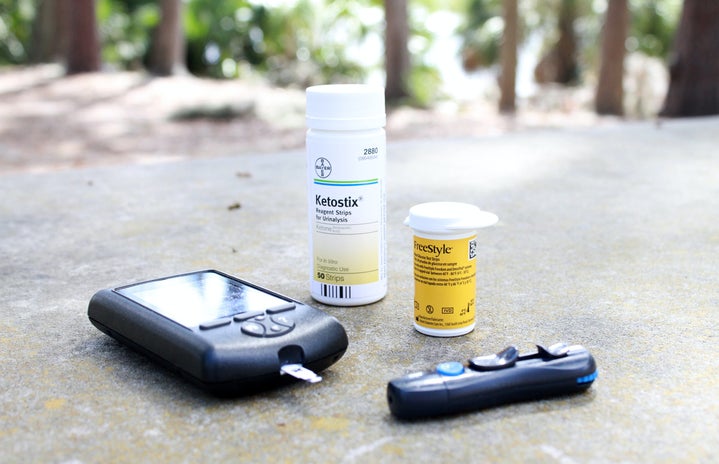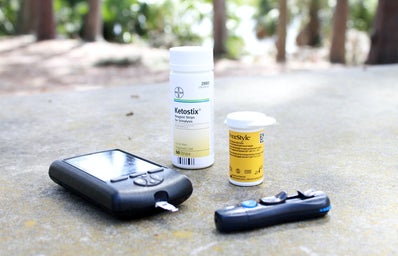Growing up, I never heard of diabetes beyond the stereotypical jokes that were made in school. It wasn’t until I was diagnosed with Type 1 Diabetes myself that I learned the severity of the condition. On September 11 in 2014, I was brought to the hospital after my blood sugar level was at 500 mg/dL after eating lunch. A non-diabetic’s blood sugar, in comparison, should be as high as 130 mg/dL after eating. After three days in the hospital, I was sent home with vials of insulin, syringes, a blood sugar testing kit, and an autoimmune disease that has no known cure.
Every year during the month of November, many diabetics worldwide come together to raise awareness on the condition. Topics include early warning signs, insulin rationing, and even just daily obstacles to help us feel more connected through our shared struggles. In this article today, I want to provide some basic information about diabetes to help you strengthen your knowledge on the subject and support any diabetics you may know.
What is diabetes?
The two most commonly known, and the two we will be discussing, are Type 1 and Type 2 Diabetes.
Type 1 Diabetes is an autoimmune disease where the pancreas produces little to no insulin. This is caused by the immune system attacking beta cells (insulin producing cells) in the pancreas mistakenly.
Type 2 Diabetes is a chronic condition where the body is resistant to insulin or the pancreas does not produce enough insulin. The ultimate cause is unknown, however, there are possible factors including genetics and environmental issues (I.e. being overweight, lack of exercise, poor diet, etc).
What are the symptoms?
Type 1 and Type 2 Diabetes do have a few similar symptoms, but there are a few important differences in their lists.
- Type 1 Diabetes symptoms:
- Extreme thirst
- Frequent urination
- Bed-wetting (for children)
- Increased appetite
- Extreme weight loss
- Easily irritable
- Mood swings
- Fatigue
- Blurred vision
- Type 2 Diabetes symptoms:
- Extreme thirst
- Frequent urination
- Increase appetite
- Extreme weight loss
- Sores with slow healing
- Constant infections
- Dark areas of the skin
What are the risk factors?
Type 1 risk factors include: family history, genetics, and age. You can be diagnosed with Type 1 Diabetes at any age, however, it’s most commonly diagnosed between the ages of 4-7 and 10-14, which is why another name for Type 1 Diabetes is Juvenile Diabetes.
Type 2 risk factors include: inactivity, poor diet, family history, race or ethnicity, being over the age of 45 years old, and weight. Being overweight increases the risk, however, you do not have to be overweight to have Type 2 Diabetes.
Is there any way to prevent it?
There is no known way to prevent Type 1 Diabetes, but research is being conducted to learn more about the disease.
For Type 2 Diabetes, there are a few ways one can prevent themselves from developing it. These practices include: regular exercise, a balanced diet, maintaining a healthy weight, avoiding a sedentary lifestyle, and seeing a physician regularly.
How is Diabetes managed?
It is important to note that there is no known cure for Type 1 or Type 2 Diabetes.
Type 1 Diabetics are insulin dependent which means they require insulin injections through either insulin injections or an insulin pump. Monitoring blood sugar regularly with blood glucose testing devices or continuous glucose monitors. Regular exercise, a balanced diet, and carb counting are also essential to manage Type 1 Diabetes.
Type 2 Diabetics may also use insulin to manage their condition, however, there are other medications that can be prescribed if their physician sees fit. Some Type 2 Diabetics can take care of themselves without the use of medication by regularly exercising, monitoring blood sugar, and eating a well balanced diet.
What is insulin? Why is it so important?
Insulin is a hormone that is made from the beta cells of the pancreas. For Diabetics that cannot produce enough or any insulin at all, their insulin can come from pig and cow pancreas glands, or it can be man-made using synthetic technology.
After we eat or drink something with carbohydrates insulin allows the body to move the glucose from our blood into the body’s cells as fat, sugar, and protein. Without insulin, the body cannot effectively function as it does not have the energy required to do so, and the blood glucose levels remain high.
Consistent high blood sugar levels have severe consequences. Long term complications of ill-managed blood sugar levels include the following:
- Heart disease
- Nerve damage
- Kidney damage or failure
- Possible blindness due to the damage of the optic blood vessels
- Damaged nerves or poor blood flow, which can lead to possible amputation feet
- Bone and joint problems
- Teeth and gum infections
Insulin dependent and desperate?
One of the struggles that is often mentioned during Diabetes Awareness Month, is the difficulty to afford the proper amount of medication necessary to manage the condition. In 1922, Frederick Banting, Charles H Best, and JJR Macleod injected insulin into their first human patient after conducting their own experiments with animals at the University of Toronto. The 14 year old boy was their first success story as his blood glucose levels steadily came down. The next year, the three men were given the Nobel Peace Prize for their achievement.
The patent for insulin was sold for $1 as the three men wanted the world to have access to the lifesaving drug. Since companies gained monopolies in the insulin industry, the prices have severely increased from the $1 patent. In 1999, a vial of fast acting Humalog insulin cost $21. In 2019, the cost had risen more than 1000% for an average cost of $332 for the same vial of insulin. Companies continue to drive up the price for insulin, knowing that those that require the medication cannot survive without it.
How can you support someone with Diabetes?
Many Diabetics have to face an extremely harsh reality when diagnosed. Especially for Type 1 Diabetes, the diagnosis of a condition with no cure can be incredibly daunting. The constant insulin injections and blood sugar testing can be overwhelming, and sometimes it can lead to depression. In fact, those with Type 1 and Type 2 Diabetes are two times more likely to have depression.
Being there to listen to a family member or friend can help them lessen the burden of their condition. When offering a listening ear isn’t something they might be interested in, actions speak louder than words. If they have low blood sugar, offer to get them their preferred snack for them while they sit down and relax. If they have high blood sugar, grab them a glass of water and ask them if they need help with anything.
If they aren’t communicating that they might need help, sometimes giving space is the best decision. When managing Diabetes, the person learns what works for them. They have a routine for themselves and they know what does or does not work. Unless you are their doctor, offering advice can feel more frustrating than helpful.
I know this article is a lot to take in, but I hope it helped answer some basic questions one might have when first learning about Diabetes. I am not as educated on other forms of Diabetes, such as type 3C, but I encourage you to take the time to learn about more forms of Diabetes. There are so many resources out there like JDRF that can help answer any more questions you might have. Don’t forget to wear blue on National Diabetes Day which is November 14, to show support for diabetics!

